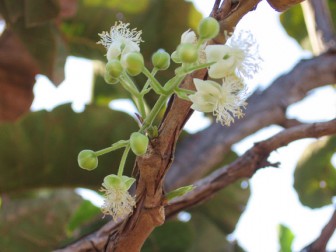This species is the most ubiquitous tree or shrub of the New World savanna biome. Widespread in orchard-type savannahs, it has a wide ecological tolerance and can endure both water surplus and deficit. The leaves contain silicon and have a rough texture. These features make them suitable for polishing wood and metals and for scouring kitchen utensils. The wood is used for fuel, charcoal, fence posts and small cabinet work.
This species is fire resistant and can lose all its leaves in a fire but can regenerate vegetatively. This behaviour is of high adaptive value in ecosystems subject to recurrent fires and seasonal drought.
The dominance of this species can be attributed to its ability to withstand and regenerate in areas where frequent disturbance and flooding occurs.
In the Rupununi savannahs, the Sandpaper tree is dominant; in this ecosystem with frequent fires (natural and man-made) as well as annual flooding, this dominance is expected. The intentional burning of savannahs for improving grazing conditions (growth of new grass), driving game from cover, getting rid of snakes, protecting villages from natural fire, and removing old grass to make way for new growth is aided by the nutrient supply from ash and rains.

Rain forests are rich in biodiversity and are home to many different plants and animals as well as indigenous communities. Humans, even those who don’t live in the rain forest, rely on it for resources such as building materials (wood and lianas), medicine and fruits. Rain forests also provide essential environmental services for life on earth; they create soil as well as prevent soil erosion, produce oxygen though photosynthesis, maintain clean water systems, and are a key defence against climate change.
The Iwokrama Rain Forest is 371,000 hectares, located in the heart of Guyana. Our mission is to develop strategies for conservation and sustainable development for local people in Guyana and the world at large. We are involved in timber, tourism and training. Come and visit us in the rain forest or at http://www .iwokrama.org.




